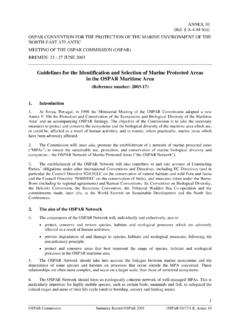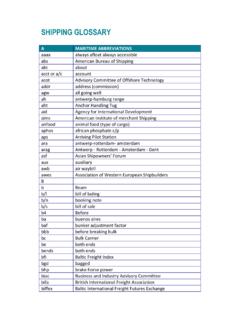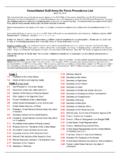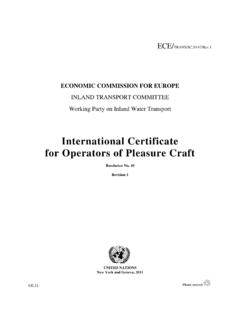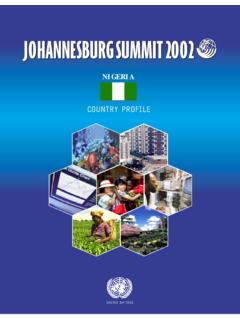Transcription of STRATEGIC ASSESSMENT OF MARITIME BUSINESS
1 FINAL REPORT STRATEGIC ASSESSMENT OF MARITIME BUSINESS PREPARED FOR PORT OF REDWOOD CITY PREPARED BY FEBRUARY 2008 STRATEGIC MARITIME ASSESSMENT Table of Contents I. Introduction .. 1 A. General .. 1 B. Port of Redwood City Profile .. 1 C. TranSystems .. 1 D. Methodology .. 2 II. SWOT 4 A. General .. 4 B. Strengths .. 6 C. Weaknesses .. 6 D. Opportunities .. 7 E. Threats .. 8 F. STRATEGIC Alternatives .. 9 G. Recommendations .. 10 H. MARITIME STRATEGIC Plan .. 11 III. Existing Cargo .. 13 A. Recyclables .. 13 B. Building Materials .. 13 IV. Other Cargo Opportunities .. 15 A. 15 B. Refrigerated .. 16 C. Short Sea Shipping .. 17 D. Forest Products .. 19 E. Summary of Terminal and Vessel Requirements .. 20 V. Competitive Landscape .. 21 VI. Infrastructure .. 22 A. Channel Dredging .. 22 B. Rail and Road Connections.
2 22 C. Land Expansion .. 23 D. Covered Bulk Storage .. 23 E. Ferry Service .. 25 VII. Appendices .. 26 A. Previous Studies .. 26 B. Port Commissioners Comments .. 27 C. Interview Contacts .. 28 STRATEGIC ASSESSMENT of MARITIME BUSINESS 1I. Introduction A. General This report is the first step towards a MARITIME STRATEGIC plan for the Port of Redwood City. The report is a top down ASSESSMENT of the MARITIME BUSINESS at the port, including a SWOT (Strengths, Weaknesses, Opportunities, and Threats) Analysis, research on the future of the dry bulk commodities comprising the port s current BUSINESS , and research on other MARITIME cargo opportunities identified in the SWOT Analysis. The current and future competitive landscape is also included in the analysis. Any subsequent steps to a full STRATEGIC plan, especially involving land expansion, should be coordinated with the City of Redwood City and their land use planning for the port area.
3 The overall objective of the STRATEGIC planning process is to describe what the port may look like in five to ten years, identify the main drivers of the port s BUSINESS , offer STRATEGIC alternatives, and define STRATEGIC activities that could be undertaken by the port. B. Port of Redwood City Profile The Port of Redwood City is located at the southwestern end of San Francisco Bay. A federally authorized 30-foot deep channel from the San Mateo Bridge to the port is used for the cargo vessel traffic. The port has five deepwater wharves that handle cargo operations. MARITIME activities include the export of recycled metals and the import of dry bulk building materials such as cement, bauxite, gypsum and aggregates. Approximately 75% of the Port s $6 million revenue per year is related to MARITIME activity, while the remainder is rental revenue from commercial leasing activities.
4 The Port is owned by the City of Redwood City, whose City Council appoints the five Port Commissioners to provide Port governance and liaison with the City. About 10% of revenues are provided to the City annually from the Port s net operating results and additional port profits are reinvested in infrastructure. The four main MARITIME tenants at the port (in order of revenues) are: CEMEX (cement, aggregates) SIMS Metal (metal recyclables) Pabco Gypsum (gypsum) International Materials Inc. (IMI) (bauxite) CEMEX produces over a third of the Port s MARITIME revenues, after their acquisitions of Harbor Sand and Gravel and RMC Pacific in 2005 established them as the primary tenant of the Port. The annual throughput tonnage at the Port is million metric tons with current capacity of more than double that number, or million tons.
5 The million tons is down from last year due to a temporary decrease in cement imports. C. TranSystems TranSystems is a transportation engineering firm headquartered in Kansas City, with over 40 offices in the The San Francisco office, formerly Manalytics International, coordinated the STRATEGIC ASSESSMENT . Similar studies have recently been conducted by this group at bulk terminals such as Mobile, Alabama; smaller ports including Humboldt Bay, California, and Corpus Christi, Texas; and large ports such as Seattle and Portland. TranSystems | Manalytics is also currently doing research work on a STRATEGIC ASSESSMENT of MARITIME BUSINESS 2 West Coast short sea shipping service for the Center for Commercial Deployment of Transportation Technologies (CCDoTT) at Cal State Long Beach. The San Francisco office is also the lead for TranSystems supply chain consulting with major shippers, including bulk shippers such as Alcoa and recycling companies like Norcal in San Francisco.
6 TranSystems other offices do extensive engineering planning and design work for numerous large and small port facilities, in addition to major railroads. D. Methodology The project was initiated with a kick-off meeting with port executives to cover: project objectives port orientation available documents interview list project schedule 1. Interviews were held with the following executives and organizations: Port Commissioners six interviews including all five current members and one past commissioner. Interviews, some multiple for follow-up discussion, were held with the following executives at the Port: - Executive Director - Economic Development Manager - Manager of Operations - Director of Finance and Administration Customer interviews included executives from: - SIMS Metal - Pabco Gypsum - CEMEX Other California ports were visited and executive interviews included: - Port of San Francisco - Port of Stockton - Port of Richmond (Levin Terminal) Other related contacted parties included: - General Steamship Corporation - Redwood City Industrial Saltworks - Metropolitan Stevedores In addition, phone or in-person interviews were held with other potential interested parties.
7 - Garden City Sanitation (recycling opportunities) - Norcal Waste (recycling market) - Allied Waste (recycling market) - Dole Fruit (refrigerated cargo in) - MTC (investment/partnerships) - Pasha (automobile imports) Telephone interviews were also conducted with providers of covered bulk storage. A list of all individuals interviewed is included in Appendix C. STRATEGIC ASSESSMENT of MARITIME BUSINESS 32. A number of documents were provided by the Port for background research material and these are listed in Appendix A, along with other outside documents used by TranSystems for the project 3. Research was conducted on various commodities such as building materials, and recyclables from internal TranSystems files and external sources. 4. An initial SWOT Analysis for the Port was conducted with the Port s executive staff and later more rigorous analysis internally by TranSystems project staff 5.
8 Reviews of preliminary findings were held with Port executive staff. 6. A presentation of the project s preliminary findings and progress was provided to the Port Commissioners on December 12, 2007 during the regular commissioners meeting. STRATEGIC ASSESSMENT of MARITIME BUSINESS 4II. SWOT Analysis A. General Tables 1A and 1B below are a summary of the SWOT Analysis or strengths, weaknesses, opportunities, and threats for the Port, performed for STRATEGIC ASSESSMENT . This analysis is further discussed in subsections B, C, D, and E. Table 1: Port of Redwood City - SWOT Analysis Summary Table 1A. Strengths Weaknesses* Established BUSINESS - Management/BOD experience and tenure - Long-term customers, SIMS and CEMEX very established at Port - Continued profitability - City of Redwood City backing - Co-existence with a balance of adjacent recreational, industrial, and commercial activities - Established legal basis for Port in City of Redwood City charter (1937) and San Francisco Bay Conservation and Development Commission (BCDC) Population Base San Mateo and Santa Clara Counties - Excellent geographic position in South Bay - Vibrant local economy drives building activity - High volume consumer of domestic and international cargo - Extensive recyclables generation from nearby residential (and commercial)
9 Activity Channel Depth - Silting, tides, shoaling - No dependable schedule for dredging - San Mateo Bridge height (135 feet) Infrastructure - Key to increased MARITIME throughput, land expansion minimal due to non- MARITIME leases - Truck/highway access poor - Little cover for dry bulk products, dust created - Existing rail volumes low (little MARITIME rail activity), cannot handle large trains Lack of diversification - No breakbulk cargo - No containerized cargo - Concentration with few bulk customers * Applies to expansion potential and existing BUSINESS . STRATEGIC ASSESSMENT of MARITIME BUSINESS 5 Table 1: Port of Redwood City - SWOT Analysis Summary Table 1B. Opportunities Threats Saltworks Land Availability - Buffer needed if residential plan approval for Saltworks - Requires separate road for commercial traffic Expansion to Other Recyclables - Yard/food/wood waste (current opportunity) - Scrap tires Automobile Imports - Local demand for product - Good buffer between Port and residential - Car carrier vessel depth requirement less than the 30-foot federal channel depth (although the 135-foot air draft of the San Mateo bridge is a constraint for the larger car carriers)
10 - Easy to stage off port property Cold Storage, Refrigerated Cargo - Currently break bulk, not container - Trucked from Southern California, PNW - Needs yard space for cross dock operation - May require deeper channel draft Short Sea Shipping - Port well positioned to offload highway traffic to San Francisco Bay and beyond - International feeder and domestic cargo possibilities Development of Shortline Railroad - Bay Area wide rail freight (domestic cargo) - More responsive and less expensive than UP - Requirement to support auto imports - Metal recyclables would be a guaranteed user Other Opportunities - Bio-diesel industry - Project cargo destined for the region - Niche break bulk cargo Highest/Best Use Land Development - Gentrification if residential development moves closer - Difficult to co-exist with uncovered dry bulk Current Demand for Building Materials - Down in the local region - Demand shifting inland to Sacramento area - Major effect on Port revenues - However, population growth in the Port s hinterland should support long term demand Funding Approval for Dredging - Not always guaranteed as needed Competitive Ports - Deeper channel depths - Better infrastructure for shipper supply chain (land, truck, rail)
